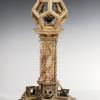Multiple ivory balls
Commentary
PRESCRIBED SOURCE
Multiple ivory balls
Dimensions.Diameter (max) 41 mm
Description.Three open-work ivory spheres turned within each other. The outermost is perforated with large holes at the poles and around the equator, where they alternate with smaller holes which also mark the tropics; four bands of bosses separate these different zones. The second sphere is also perforated by two sizes of holes, one of the larger ones being plugged by an elaborate stopper. The third sphere has a large hole at each pole and four more around the equator; four integral spikes radiate from each tropic. In the centre is a cube with a hole through each side, from which spikes of a free star-shaped body radiate on four (originally six) sides.
Commentary.The overall form of the sphere is first shaped on a lathe from a solid block of ivory. The surface area is then divided up geometrically according to the number of perforations required and the centres of the perforations are carefully marked. The piece is then remounted on the lathe in a special sleeve or chuck so that one of the marked centre-points is aligned with the mandrel and in this position a hole of appropriate size is turned out to the desired depth. Each centre-point is presented in turn and the process repeated. The perforations are normally cut so that they taper towards the centre of the body, and, if radiating spikes are required, these may be left in reserve in the middle of the perforation; alternatively, sockets for separate spikes may be drilled in the solid central body. Finally, each perforation is realigned in turn on the lathe and, with the aid of a hooked or right-angled gouge, the turner cuts sideways at predetermined depths to form the internal elements, each being detached in sequence starting with the innermost. The origin of this technique can be traced to the second half of the sixteenth century, when a tremendous vogue for intricate and artistic lathe-turning developed in southern and central Germany. Patronage by the courts was eagerly extended to the most talented craftsmen, while the appetites of bourgeois collectors were catered for by commercial suppliers. Simple elegance played no part in this movement, which constantly strove to extend the limits of technical virtuosity rather than aesthetic refinement.
Museum Id. No:
1656 p. 39: Divers sorts of Ivory-balls turned one within another, some 6, some 12 folds; very excellent work
1685 A no. 340: Tres globuli eburnei perforati; singuli in triginta partim hexangula partim quinquangula alternatim posita, alius intra alium mire detornati; in quorum centro globulus solidus mobilis, aculeis hirsutus per foramina trajectis
Credits: Abridgedfrom H. R. Singleton, 'Runic almanac', in Arthur MacGregor (ed.),Tradescant's Rarities: Essays on the Foundation of the Ashmolean Museum (Oxford, 1983), pp. 288-9.




